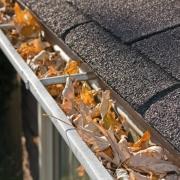Home Maintenance Projects to Complete Before Fall
There’s a nip in the air, and it’s time to get your home ready for fall. Start by checking smoke and carbon monoxide detectors (and replacing batteries).
Add a roof inspection to your list to prevent water damage, mold growth and more. Then, seal and caulk cracks around windows, doors and where pipes and wires enter the house.
1. Clean Your Gutters
When leaves start falling and the days get shorter, it’s time to clean your gutters. Gutter debris is one of the most overlooked home maintenance tasks, but it’s vital to keeping your home healthy.
Clogged gutters prevent water from draining properly, which can cause problems like roof damage and foundation erosion. In addition, a buildup of standing water creates moist environments where mold and mildew thrive. Mold is not only unsightly but can cause breathing issues for those with allergies and asthma.
Keeping your gutters clean is a simple and inexpensive way to protect your home from serious damage, so don’t put it off. Depending on the type of trees surrounding your home, you may need to clean your gutters 3 or 4 times per year.
Before the cold weather hits, you should take a ladder and remove any debris from your gutters, eavestroughs, and downspouts. In cold climates, a buildup of debris in your gutters can cause ice dams, which can block melting snow from draining off the roof.
While you’re at it, grab a tube of color-matched exterior caulk and seal any cracks in your home’s siding, around windows and door frames, and where pipes and wires enter the house. This will ward off cold air and unwanted pests and prevent moisture from seeping into your walls and causing costly repairs.
2. Replace Your Furnace Filter
Regularly replacing your furnace filter helps to protect the system and improve air quality in your home. It also saves energy and extends the life of your furnace. It’s a simple project that can be done on your own without an expensive service visit from a professional. It only takes minutes to complete, but you’ll reap the benefits all season long.
Before you replace your filter, make sure the furnace is off by turning on the power switch next to it or at the fuse box. This is to prevent injury or damage to the system. Then open or slide the service panel. Most filters are located in or near the blower compartment of your furnace. You may need a screwdriver to open the panel, so it’s a good idea to keep one nearby.
Once you’ve opened the panel, remove the old filter and set it aside. Be careful not to shake or bang the old filter, as this could release the trapped contaminants back into your air. Place it in a plastic garbage bag before disposing of it. Then put in the new filter, following any arrows or directions on the package.
3. Inspect Your Windows
The onset of fall means sweater weather, football season and pumpkin spice-everything. However, it also means it’s time to start thinking about preparing your home for winter.
The first thing you’ll want to do is inspect your windows. This includes removing any screens, making repairs and replacing any that are worn out, and properly cleaning the window. Then, you can take advantage of the moderate weather to caulk cracks around your windows and doors before the cold air sets in.
This is a good time to test and replace the batteries in your smoke and carbon monoxide detectors, as well. You’ll also want to make sure that any fire extinguishers in your home are still in working order, and that you reverse the direction on your ceiling fans to push warm air down (the opposite of what they do in the summer).
4. Check Your Irrigation System
When the temperature starts dropping, it’s time to prepare your irrigation system for winter. Shutting off the water supply to the entire system, opening the drain valve, and blowing out the pipes with compressed air is a good way to protect your irrigation system from freezing in the winter. Insulating exposed pipes is also important to prevent them from bursting in the cold.
You may also want to consider adding a smart irrigation system that can be controlled from your smartphone or tablet. This makes the job of maintaining your home’s landscape and lawn even easier.
If you have a sprinkler system on your property, it’s a great idea to schedule an inspection for the fall. A professional irrigation specialist can reprogram all the settings to the proper time of year for your lawn or landscaping, which will help you avoid unnecessary water use and wasted money on your energy bill.
In addition to checking your irrigation, you should also inspect the roof and seal any cracks and gaps around trim and siding with caulk. This will keep cold air and unwanted pests out, as well as lower your energy bills. In addition, if your home is located in an area prone to moss growth, add a coat of moss-killing granules to the roof before the first rain storm of fall.






